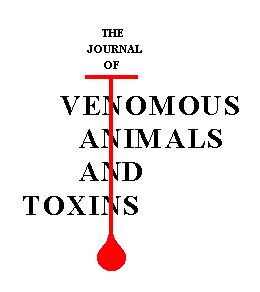Mini-Symposium - Abstracts
1 IS ENZYMATIC ACTIVITY IN THE BOTHROPSTOXIN-I FRACTION DUE TO THE K49 PHOSPHOLIPASE STRUCTURE ?
J.E. FLETCHER , M. JIANG
, M. JIANG , J.R. GIGLIO
, J.R. GIGLIO
 Department of Anesthesiology, Allegheny University of Health Sciences, Philadelphia, USA;
Department of Anesthesiology, Allegheny University of Health Sciences, Philadelphia, USA;  Department of Biochemistry, University of São Paulo, Ribeirão Preto, SP, Brazil
Department of Biochemistry, University of São Paulo, Ribeirão Preto, SP, Brazil
Some investigators have dismissed a role for enzymatic activity in the toxicity of K49 PLA2 myotoxins based on catalytically inactive mutant D49Ks derived from bovine or porcine pancreatic D49 PLA2s. Caution should be used in extrapolation of the results of these sitedirected mutagenesis studies, since there are structural features unique to the K49 PLA2 myotoxins in addition to the lysine for aspartic acid substitution that could be required for enzymatic activity. Some K49 PLA2 fractions have trace enzymatic activity that has been demonstrated (based on activity on purified substrates) to be due to contamination with D49 PLA2 enzymes from the same venom. We chose to examine this question in detail using a K49 PLA2 myotoxin, bothropstoxin-I (BthTX-I; SPIII SPV) from Bothrops jararacussu venom and two D49 PLA2 enzymes from the same venom. Unlike other K49 PLA2 fractions demonstrated to contain trace contamination with D49 PLA2 enzyme from the same venom, the BthTX-I fraction in the present study had no detectable enzymatic activity on egg yolk phosphatidylcholine (PC) at a concentration of 200µg/ml. In contrast, BthTX-I had significant enzymatic activity in the range of concentrations of 0.1-5µM when tested on cell cultures in which the lipids were radiolabeled. The enzymatic activity in these cultures for BthTX-I was at least 1.8-fold more attenuated by the presence of bovine serum albumin (BSA) than that of either of the D49 PLA2 enzymes from the same venom. The effects of elevating the Ca concentration from 2 mM to 10 mM were even more revealing. The enzymatic activity of the D49 PLA2 myotoxin, BthTX-II (SPIII SPIV), was unaffected by the change in Ca
concentration from 2 mM to 10 mM were even more revealing. The enzymatic activity of the D49 PLA2 myotoxin, BthTX-II (SPIII SPIV), was unaffected by the change in Ca concentration. The activity of the predominant D49 PLA2 (SIII SPII) was only decreased by about 25%, yet that of BthTX-I was decreased by about 60%. Since the nonmyotoxic SIII SPII PLA2 was most similar to BthTX-I in the effects of BSA and Ca
concentration. The activity of the predominant D49 PLA2 (SIII SPII) was only decreased by about 25%, yet that of BthTX-I was decreased by about 60%. Since the nonmyotoxic SIII SPII PLA2 was most similar to BthTX-I in the effects of BSA and Ca on enzymatic activity, we examined the substrate preference of these two enzymes. While the substrate preferences toward PC and phosphatidylethanolamine were similar for the two PLA2 fractions in the absence of BSA, the activity toward PC was greatly decreased for BthTX-I than for the SIII SPII D49 enzyme when BSA was added to the medium. These studies suggest that the enzymatic activity of the K49 BthTX-I fraction on biological substrates is due to the myotoxin molecule, not contamination with a D49 PLA2 from the same venom.
on enzymatic activity, we examined the substrate preference of these two enzymes. While the substrate preferences toward PC and phosphatidylethanolamine were similar for the two PLA2 fractions in the absence of BSA, the activity toward PC was greatly decreased for BthTX-I than for the SIII SPII D49 enzyme when BSA was added to the medium. These studies suggest that the enzymatic activity of the K49 BthTX-I fraction on biological substrates is due to the myotoxin molecule, not contamination with a D49 PLA2 from the same venom.
CORRESPONDENCE TO:
Dr. Jeffrey E. Fletcher - Department of Anesthesiology, Medical College of Pennsylvania and Hahnemann University, Broad & Vine, Mail Stop 310, Philadelphia, PA, 191002-1192, USA. email: fletcherj@allegheny.edu
Publication Dates
-
Publication in this collection
08 Jan 1999 -
Date of issue
1997

